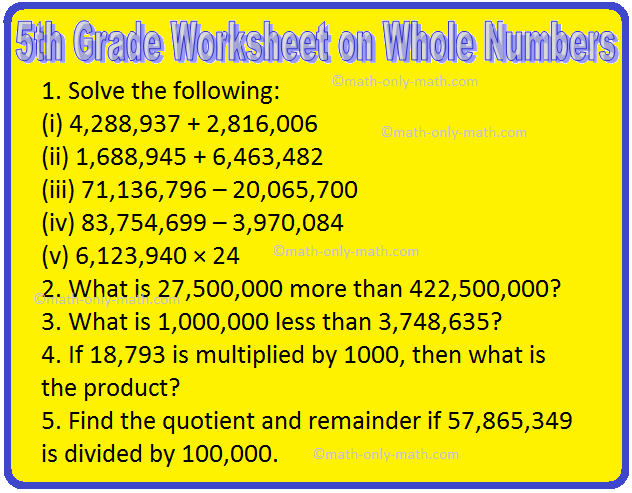Subscribe to our ▶️ YouTube channel 🔴 for the latest videos, updates, and tips.
5th Grade Worksheet on Whole Numbers
In 5th Grade Worksheet on Whole Numbers contains various types of questions on operations on Large Numbers. The questions are based on Compare actual and the estimated numbers, mixed problems on addition, subtraction, multiplication and division of whole numbers, round off the large numbers, multiple choice questions on whole numbers.
1. Solve the following:
(i) 4,288,937 + 2,816,006
(ii) 1,688,945 + 6,463,482
(iii) 71,136,796 – 20,065,700
(iv) 83,754,699 – 3,970,084
(v) 6,123,940 × 24
(vi) 7,846,925 × 30
(vii) 8,024,280 ÷ 120
(viii) 1,634,785 ÷ 155
2. What is 27,500,000 more than 422,500,000?
3. What is 1,000,000 less than 3,748,635?
4. If 18,793 is multiplied by 1000, then what is the product?
5. Find the quotient and remainder if 57,865,349 is divided by 100,000.
6. Compare actual and the estimated answer to the nearest 10. Put <, > or =
(i) 4,866,720 + 3,618,270 ____ 7,900,000
(ii) 4996 × 312 ____ 1,200,000
(iii) 1,203,592 ÷ 56 ____ 5000
(iv) 6,833,005 – 5,542,806 ____ 1,400,000
7. Adding 32,801 and 3199 and dividing the sum by 9 gives
8. The quotient of the predecessor of 3,450,001 divided by 10,000 is
9. What number when multiplied by the successor of 899 gives 3,600,000?
10. Round off the given numbers and find the answers.
11. Complete the given multiplication Pyramids. One has been done for you.
12. Choose the right answer:
(i) When we add zero to any number, the answer is
(a) 0
(b) 10
(c) Number itself
(ii) The predecessor of 6,573,800 is
(a) 6,573,801
(b) 6,573,799
(c) 6,573,800
(iii) 38,606,755 + 7,682,506 is same as
(a) 38,606,755
(b) 7,682,506 + 38,606,755
(c) 7,682,506
(iv) Dividing 3,674,865 by 10,000 will give remainder:
(a) 4865
(b) 74865
(c) 865
(v) Subtracting 1 from a number gives ________ of the number.
(a) Predecessor
(b) No change
(c) Successor
(vi) The product of a number and 1 is the:
(a) 0
(b) 10
(c) Number itself
(vii) 39 + 21 ÷ 7 – 12 =
(a) 40
(b) 39
(c) 30
(viii) 486 × 1000 ÷ 5 - 5999
(a) 91,201
(b) 13,000
(c) 900,000
Answers on 5th Grade Worksheet on Whole Numbers are given below to check the exact answers of the questions.
Answer:
1. (i) 7,104,943
(ii) 8,152,427
(iii) 51,071,096
(iv) 79,784,615
(v) 146,974,560
(vi) 235,407,750
(vii) 66,869
(viii) 10,547
2. 450,000,000
3. 2,748,635
4. 18,793,000
5. quotient = 578 and remainder = 65,349
6. (i) >
(ii) >
(iii) >
(iv) <
7. 4,000
8. 345
9. 4,000
10.
11.
12. (i) (c) Number itself
(ii) (b) 6,573,799
(iii) (b) 7,682,506 + 38,606,755
(iv) (a) 4865
(v) (a) Predecessor
(vi) (c) Number itself
(vii) (c) 30
(viii) (a) 91,201
5th Grade Math Problems
From 5th Grade Worksheet on Whole Numbers to HOME PAGE
Didn't find what you were looking for? Or want to know more information about Math Only Math. Use this Google Search to find what you need.







New! Comments
Have your say about what you just read! Leave me a comment in the box below. Ask a Question or Answer a Question.